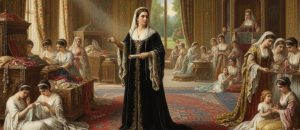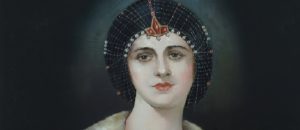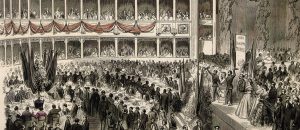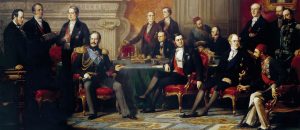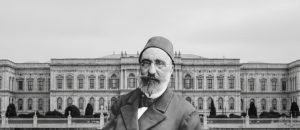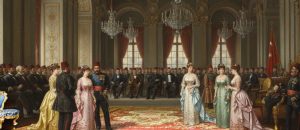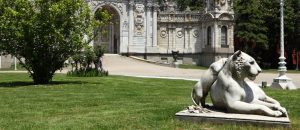A “sultan” (princess) born in Dolmabahçe Palace had a completely different style of education and upbringing than her ancestors in Topkapı Palace. Instead of a life confined to the closed world of the Harem, restricted to traditional handicrafts and religious education, they received a modern education shaped by piano lessons, French conversations, reading Western literature, and European adab-ı muaşeret (etiquette) rules. This fundamental change is the clearest indicator of how Westernization transformed not only architecture or politics but also the most private sphere—the identity and worldview of the dynasty’s women. The princesses of Dolmabahçe were a generation that grew up in the last period of the Ottoman Empire and pioneered the first enlightened women of the modern Republic. [Link: The Dynasty and its women in Dolmabahçe -> /learn/the-dynasty-and-its-people]
From Behind the Lattice to the Bosphorus View: Changing Place, Changing Vision
The foundation of this revolution in a princess’s education lies in the place where she lived, namely Dolmabahçe Palace. The Topkapı Harem offered a life behind windows called “kafes” (lattice), facing inner courtyards and almost completely isolated from the outside world. This architecture dictated an introverted and isolated lifestyle. The Dolmabahçe Harem, on the contrary, looked directly onto the Bosphorus—that is, the world and international ship traffic—with its enormous windows. This architectural change alone fundamentally altered the vision and world perception of the women living inside. They were now looking at the world not from behind the lattice, but from the showcase of the palace. [Link: Architectural and social transformation of the Dolmabahçe Harem -> /kafes-arkasindan-bogaz-manzarasina-dolmabahce-hareminin-kadinlari-nasil-degisti]
The New Curriculum: The Education of a Western “Lady”
The education of a princess in Dolmabahçe was designed parallel to the education of a European aristocratic woman, alongside traditional Islamic and Ottoman education. The cornerstones of this new curriculum were:
Western Languages, Especially French: French, the language of international diplomacy and culture in the 19th century, was indispensable for the princesses’ education. Accompanied by European governesses (mürebbiyeler) specially brought to the palace, they learned, spoke, read, and wrote French from a young age. This was a key that provided them direct access to Western culture.
** Western Music and Piano:** The piano had become one of the most important status symbols of the Dolmabahçe Harem. Princesses learned to play the piano and other Western instruments from European music teachers, performing works by composers such as Chopin and Liszt. This was not just a hobby, but also an indication that they possessed modern and refined taste.
** Etiquette (Adab-ı Muaşeret):** Social skills such as European dining etiquette, dancing, hosting guests, and the art of conversation were an important part of their education. This ensured they were equipped to [Link: host foreign guests -> /bogazicinde-bir-imparatorice-eugenie’nin-dolmabahce-ziyareti-istanbulu-ve-sarayi-nasil-buyuledi] or assume the role of a modern hostess in a Pasha’s mansion if they made a strategic marriage.
Synthesis of Tradition and Modernity
Despite this Western education, the princesses continued to receive their traditional training. They learned to read the Holy Quran (Kuran-ı Kerim), took lessons on traditional Ottoman arts such as calligraphy (hat) and illumination (tezhip), and studied Ottoman history and literature. The goal was not to create entirely Westernized individuals, but rather to raise princesses who mastered both cultures, possessed a synthesized identity, and could build a bridge between the East and the West. They were both an Ottoman sultan (princess) and a European “lady”.
Pioneering the Enlightened Women of the Republic
The last generation of princesses who received this modern education in Dolmabahçe were able to survive in the Western world thanks to this preparedness when the dynasty was exiled after the proclamation of the Republic. These women, who could communicate with the outside world, knew foreign languages, and understood art and culture, emerged from the closed world of the Harem and became individuals of the modern world. These princesses (for example, Ayşe Sultan or Sabiha Sultan), who wrote their memoirs in exile, engaged with art, or took an active role in social life, are a result of the education they received. Unwittingly, within the walls of the Harem, they were raised as the first examples of the enlightened and modern female profile of the Republic of Turkey.
Conclusion
In conclusion, growing up as a princess in Dolmabahçe Palace was a modern and cosmopolitan experience, entirely different from that of their ancestors in Topkapı. The piano and French were the strongest symbols of this new educational approach. This education shows that Westernization was not only a political project but also an effort to create a new human type and a new identity by penetrating the most private layers of the dynasty. The princesses of Dolmabahçe were pioneering figures who grew up during the last days of an empire but paved the way for the ideal of the enlightened women of a new republic.








